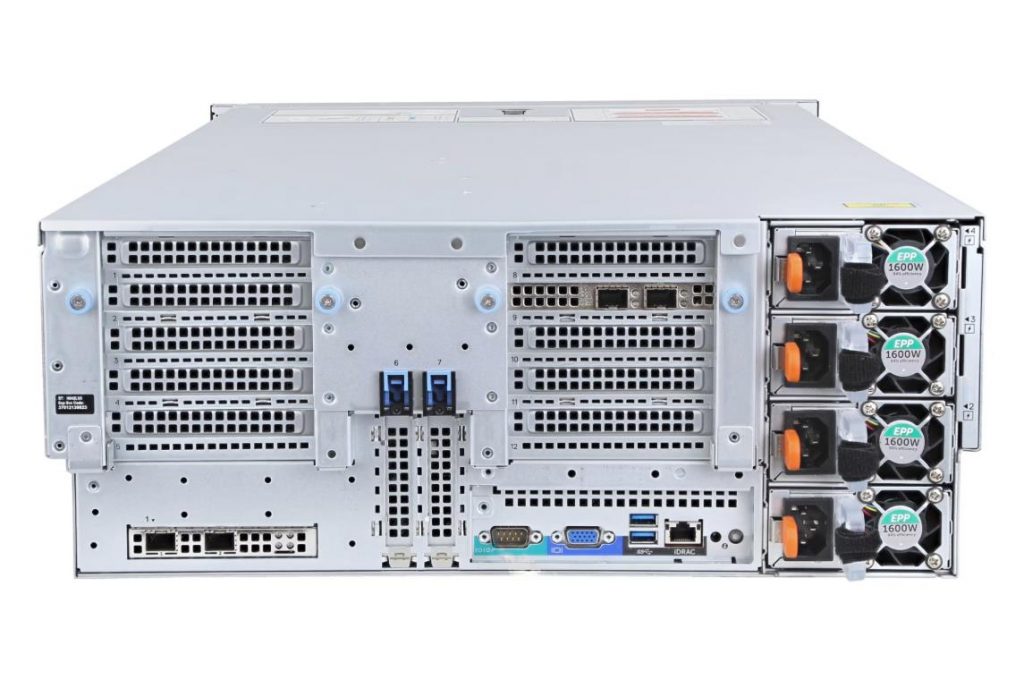Are there any comparable servers to the Dell PowerEdge R940xa in the market?
Several enterprise servers on the market offer comparable performance and features to the Dell PowerEdge R940xa for GPU-accelerated, compute-intensive workloads like AI/ML, HPC, and large-scale data analytics. Below are the top competitors, categorized by key capabilities:

1. HPE ProLiant DL380a Gen11
Key Specs
Processors: Dual 4th/5th Gen Intel Xeon Scalable (up to 64 cores) or AMD EPYC 9004 series (up to 128 cores).
Memory: Up to 8 TB DDR5 (24 DIMM slots).
GPU Support: Up to 4 double-wide GPUs (e.g., NVIDIA H100, A100) via PCIe Gen5 slots.
Storage: 20 EDSFF drives or 8x 2.5" NVMe/SATA/SAS bays.
Management: HPE iLO 6 with Silicon Root of Trust for security.
Use Case: Ideal for hybrid cloud, AI inference, and virtualization. While it’s a 2-socket server, its GPU density and memory bandwidth rival the R940xa’s 4-socket design in certain workloads.
2. Supermicro AS-4125GS-TNRT (Dual AMD EPYC 9004)
Key Specs
Processors: Dual AMD EPYC 9004 series (up to 128 cores total).
Memory: Up to 6 TB DDR5-4800 (24 DIMM slots).
GPU Support: Up to 8 double-wide GPUs (e.g., NVIDIA H100, AMD MI210) with PCIe Gen5 connectivity.
Storage: 24x 2.5" NVMe/SATA/SAS drives (4 dedicated NVMe).
Flexibility: Supports mixed GPU configurations (e.g., NVIDIA + AMD) for workload-specific optimization.
Use Case: Dominates in AI training, HPC, and edge computing. Its 8-GPU capacity outperforms the R940xa’s 4-GPU limit for parallel processing.
3. Lenovo ThinkSystem SR950 V3
Key Specs
Processors: Up to 8 Intel Xeon Scalable processors (28 cores each).
Memory: 12 TB DDR4 (96 DIMM slots) with support for persistent memory.
GPU Support: Up to 4 double-wide GPUs (e.g., NVIDIA A100) via PCIe Gen4 slots.
Storage: 24x 2.5" drives or 12x NVMe U.2 drives.
Performance: Holds multiple SPECpower and SAP HANA benchmarks, making it ideal for mission-critical databases.
Use Case: Targets ERP, SAP HANA, and large-scale transactional workloads. While its GPU support matches the R940xa, its 8-socket design excels in multi-threaded applications.
4. IBM Power Systems AC922 (Refurbished)
Key Specs
Processors: Dual IBM Power9 (32 or 40 cores) with NVLink 2.0 for GPU-CPU coherence.
Memory: Up to 2 TB DDR4.
GPU Support: Up to 4 NVIDIA Tesla V100 with NVLink for AI training.
Storage: 2x 2.5" SATA/SAS drives.
Ecosystem: Optimized for Red Hat OpenShift and AI frameworks like TensorFlow.
Use Case: Legacy HPC and AI workloads. Refurbished units offer cost savings but may lack modern GPU compatibility (e.g., H100).
5. Cisco UCS C480 M6
Key Specs
Processors: Dual 4th Gen Intel Xeon Scalable (up to 60 cores).
Memory: Up to 6 TB DDR5 (24 DIMM slots).
GPU Support: Up to 6 double-wide GPUs (e.g., NVIDIA A100, L40) via PCIe Gen5 slots.
Storage: 24x 2.5" drives or 12x NVMe U.2 drives.
Networking: Built-in Cisco UCS Manager for unified infrastructure management.
Use Case: Balances GPU density and storage scalability for edge AI and distributed data solutions.
6. Huawei TaiShan 200 2280 (ARM-Based)
Key Specs
Processors: Dual Huawei Kunpeng 920 (ARM-based, 64 cores).
Memory: Up to 3 TB DDR4 (24 DIMM slots).
GPU Support: Up to 4 PCIe Gen4 GPUs (e.g., NVIDIA T4).
Storage: 24x 2.5" drives for software-defined storage.
Use Case: Optimized for cloud-native and ARM-compatible workloads, offering energy efficiency but limited GPU performance compared to x86 alternatives.
Key Considerations for Comparison
Multi-Socket Performance
The R940xa’s 4-socket design excels in CPU-bound workloads, but competitors like the Supermicro AS-4125GS-TNRT (dual EPYC 9004) and HPE DL380a Gen11 (dual Xeon/EPYC) often match or exceed its GPU performance with higher core density and PCIe Gen5 bandwidth.
GPU Flexibility
Supermicro’s AS-4125GS-TNRT supports up to 8 GPUs, while the R940xa is limited to 4. This makes Supermicro a better fit for large-scale AI training clusters.
Memory and Storage
The Lenovo SR950 V3 (12 TB) and HPE DL380a Gen11 (8 TB) outperform the R940xa’s 6 TB memory ceiling, critical for in-memory databases like SAP HANA.
Cost vs. New/Refurbished
Refurbished IBM AC922 units offer Tesla V100 support at a fraction of the R940xa’s cost, but lack modern GPU compatibility. New Supermicro and HPE models provide better future-proofing.
Ecosystem and Software
Dell’s iDRAC integrates seamlessly with VMware and Microsoft environments, while IBM Power Systems and Huawei TaiShan favor Linux and ARM-specific stacks.
Conclusion
For direct GPU-accelerated workloads, the Supermicro AS-4125GS-TNRT (8 GPUs) and HPE DL380a Gen11 (4 GPUs) are the closest competitors, offering superior GPU density and PCIe Gen5 connectivity. For multi-socket CPU performance, the Lenovo SR950 V3 (8-socket) and Cisco UCS C480 M6 (6 GPUs) stand out. Refurbished IBM AC922 units provide budget-friendly alternatives for legacy AI/HPC workloads. Ultimately, the choice depends on your priorities: GPU scalability, multi-threaded CPU power, or cost-efficiency.



